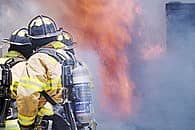National Preparedness Month is an annual event to raise awareness about the importance of preparing for disasters and emergencies. Although the focus of the campaign is on different aspects of preparedness for individuals, families, and communities, this is also a great time to evaluate workplace emergency preparedness and determine if your facility is ready to respond to an emergency situation such as a fire, spill, or employee exposure.
The first step is to develop a comprehensive written Emergency Action Plan or Contingency Plan. Contingency Plans are needed for large quantity generators (LQGs) of hazardous waste in place of Emergency Action Plans. These plans are required by various regulations including OSHA 29 CFR 1910.38 and 157, Massachusetts Comprehensive Fire Safety Code 527 CMR 1.0, and the Massachusetts Department of Environmental Protection 310 CMR 30.000. The plan developed for your site needs to be specific to the hazardous materials present and site-specific operations.
All employees must have access to the written plan and be trained on it. It’s a good practice to hold drills for the various emergency situations that could arise at your site. Fire drills are recommended at least annually. In addition, holding mock spill training is a great way to enforce proper spill response procedures. It’s nearly impossible to predict how individuals will respond in a true emergency situation so providing an opportunity to practice is key to successful planning.
The Emergency Action Plan or Contingency Plan must be updated as programs change and companies grow. Any major changes such as a newly designated Emergency Coordinator or modification to the rally point should be incorporated when they take place. Also consider less obvious modifications to the program including the introduction of new hazards to the facility, changes in chemical use resulting in increased spill potential, or modifications to waste storage locations. In addition, if any part of the written plan fails in an emergency situation, the plan must be reviewed and revised to reflect the appropriate response measures.
In addition to having a written plan and conducting training on it, emergency contact information should be posted throughout the facility. Having a ‘bail-out binder’ to take with you in the event of an evacuation can also be very helpful to ensure a smooth response.
The contents of the bail-out binder should include information that would be needed for emergency responders and company personnel to reference during an evacuation. This includes emergency contact information, roll call lists, a floor plan showing the locations of hazardous materials, and safety data sheets for highly hazardous chemicals or chemicals present in large volumes. The bail-out binder should be located at the reception desk, or other convenient location that is easily accessible in the event of an evacuation. Appropriate individuals, such as emergency coordinators, should be designated to take the binder on their way out of the building.
For additional information on National Preparedness Month, or for assistance with developing or updating an Emergency Action Plan, Contingency Plan, or bail-out binder for your facility, please email [email protected].
This blog was written by Beth Graham, our Associate Director of Quality, Research, and Training

